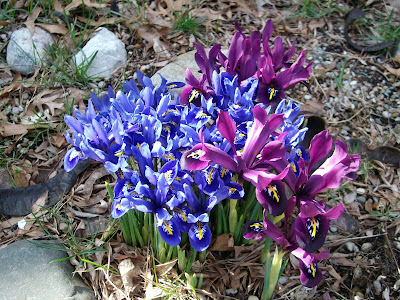One of the best displays so far has been from Iris reticulata. Most people are more familiar with the bigger irises, especially the tall bearded German irises, with their fuzzy beards and myriad colors; the tall but smaller-flowered Siberians; or the elegant, water-loving Japanese iris. I've grown all three types over the years and they are all beautiful. The Japanese are hard to keep going if you don't have a pond area. The German iris need a sunnier, grittier area than I have in my present garden, but I do have dwarf bearded in scree beds that will no doubt be featured in a later post. The Siberians are very reliable and lovely and photos of them will be forthcoming later in the season as well.
But those three types are tall, summer-blooming irises that grow from rhizomes--tuberous clumps that look a little like the ginger roots in the produce department. Whereas the little charmer I'm showing off in these photos today is grown from a tiny bulb no bigger than your thumb, planted deep into a well-drained soil. The flowering plant is short and early.
I planted most of these clusters more than ten years ago, so it's taken a while for them to get nice and full. There are a number of varieties, of which I have two--the deep purple and the royal blue. They all have that amazing pattern on the brilliant yellow on the inside of the petals.
The purple ones began to bloom slightly before the blue ones this year. Some years, the purple ones are almost finished before the blue ones appear. The mixture makes for an especially nice show.
Once the blooms are finished, the tall stiff foliage spikes keep growing and get quite tall before they disappear completely for the year. They don't last very long once the weather gets quite warm, but they are certainly colorful and charming in the early spring!
Clusters of the reticulatas are spread out in our four scree beds, but they have done the best in the sunniest one. The raised beds were built about fifteen years ago, and now they are all disintegrating at once! Hopefully, this spring Bryan, our "garden rehabilitation" helper will work toward renewing some of them.
For right now, the irises are the only source of color in scree beds except for the majestic adonis (see my earlier posts).
The crocus have been less robust this year, and I'm not sure why. The very early "tommies" in the north were lovely but didn't seem to last as long as some other years. The snow crocus in the south haven't made much of a show (that area has been getting quite shady as the maple has grown huge), and the slightly larger hybrids haven't shown up yet. Maybe they will emerge later.
 But I love the crocus for their bravery in the face of early spring weather, their delicate charm, their striped grass-like foliage, and their cheerful orange centers. As long as we wait to mow, they will return.
But I love the crocus for their bravery in the face of early spring weather, their delicate charm, their striped grass-like foliage, and their cheerful orange centers. As long as we wait to mow, they will return.In the south lawn not far from the crocus plantings are the Chionodoxa luciliae 'Pink Giant', sometimes called "The Glory of the Snow."
These little cuties are a pale creamy pink, but the most common ones are blue. In the north, we have some of the Chionodoxa sardensis, which are smaller but a lovely gentian blue with a white eye. (Photos to come later when it stops raining!)
The pink giants have been especially reliable and seem to have spread quite a bit as well. Like the crocus, if we wait on mowing, the bulbs can renew their energy and then disappear above ground, ready to return next spring.
The Corydalis solida (I think this is the variety called George Baker) is another very early and brief spring visitor, but always an impressive one with its wonderful rose color. The corydalis are sometimes called "fumeworts."
The color is really strong on a sunny day, but it's not easy to photograph. This next shot was taken by my husband David.
Lots of other bulbs are on the way now. Yellow trumpet daffodils have started on the east fence and miniature tete-a-tete daffodils in the north. I see foliage for species tulips and the later darwins alike.
In the fern bed, shade-loving perennials are gearing up as well. There is bloodroot beginning, and the white hellebore. This is an older plant, and it's probably Helleborus niger, sometimes called "The Christmas Rose." They are slow glowing and a little tricky to establish at first, but then they are very reliable shade plants.
This one has white flowers that point downward on short stems, but there are new hybrids with upward facing flowers on taller stems in shades of pink and red with spots that I'd like to try some time.
I hope you enjoyed this spring display. There will be more to come!
















No comments:
Post a Comment